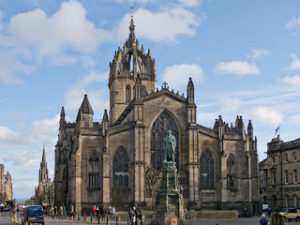Door Christopher Joby

It is perhaps unsurprising that there was a Dutch/Flemish community in early modern Edinburgh. Lowland Scotland was primarily for the Reformation, with a church similar in theology to the Dutch Reformed church. The city lies on the other side of the North Sea from the Low Countries (well, a little to the north) and there were plenty of trading connections between Scotland and the Low Countries in the Middle Ages. The Dutch/Flemish community in Edinburgh included textile workers. Indentures were made in Dutch between local employers and weavers for the Low Countries. The Dutch artist Adrian Vanson worked at the court of James VI and his wife, Susanna de Colone, traded in Edinburgh on her own account.
In 1587 an Act of Parliament was passed to allow ‘Flemings […] to have a kirk and minister of their own’. This is suggestive of a Dutch-language church although to date I have found no firm evidence of this. In 1630, the Burgh records indicate that a Dutch schoolmaster was appointed: ‘David Phorbous, Dutche scoolemaister for teaching the Dutch language within the Burgh’. Dutch diplomats such as Hadrianus Damman, came to the Scottish court and Dutch and Flemish merchants and sailors came to Edinburgh and the nearby port of Leith. Any linguistic influence of Dutch on Scots is not easy to evaluate given their common roots -for example the Scots ‘kirk’ is cognate with the Dutch ‘kerk’ for church. One suggestion for Edinburgh is that the unpopular town guard, the Toun Rats, take their name from the Dutch ‘rot(e)’ meaning a file of soldiers. Flemish weavers introduced dolls known as ‘Flanders Babies’, a type of chest, ’the Flanders kist’ and mirrors called ‘keeking glasses’ (kijken = ’to look’ in Dutch).
Further reading
Christopher Joby, The Dutch Language in Britain (1550-1702). Leiden: Brill, 2015, esp. Chapter 7.
Woordenboek der Nederlandsche Taal, ‘rot’.
Dit stukje verscheen eerder op The History of Dutch.
Leuk.
Zo blijkt maar weer dat de Noordzee toen ook al een middelpunt van Handel en volksverhuizingen was.
Vriendelijke groet,